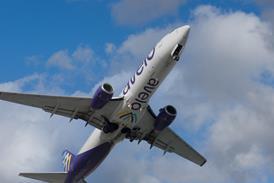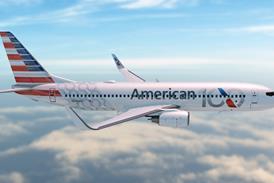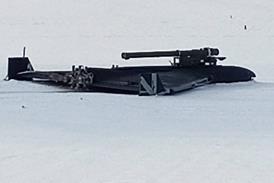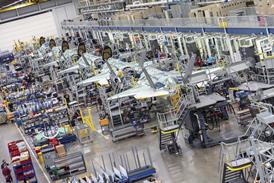Hands are finally being shown in the first round of the high-stakes poker contest that will decide which manufacturers will build the thousands of engines that will power the next generation of "green" narrowbody airliners. The problem is that the game has begun despite the fact that the players are unsure of the rules.
July's Farnborough air show provided an insight into the thinking of the "big three" engine makers - General Electric, Pratt & Whitney and Rolls-Royce - but Airbus and Boeing did little to flesh out their plans for their respective A320- and 737-family replacements.
GE, together with its CFM International partner Snecma, and P&W laid their cards on the table at the show and committed to delivering specific performance improvements by pre-determined dates, while R-R adopted a more cautious "wait-and-see" approach.
But while Airbus has the bulk of its product-development efforts focused on the A350 long-range widebody twin, and Boeing has its hands full with the troubled 787 programme, airlines have seen fuel bills for their short-haul operations rocket just as they come under increasing pressure to reduce their noise and emissions footprints. And yet production rates and order backlogs for current-generation narrowbodies are at record levels, apparently reducing the incentive for Airbus and Boeing to spend billions on all new offerings.
Although the urgency for pressing the button on the all-new single-aisle developments may not be immediately apparent to the airframers, many in the industry are convinced that these projects are critical to the airline industry's ability to sustain profitable growth, and therefore crucial to the future profitability of the manufacturers themselves.
Many believe that the industry simply cannot afford to spend billions developing new 150-seat airliners that deliver an incremental fuel-burn reduction. Operators of A320s and 737s will delay replacing them, with no economic incentive for buying new aircraft.
 |
|---|
© Pratt & Whitney |
Key to delivering the sought-after step-changes in aircraft environmental performance and operating economics will be radical new engine technology, such as open rotor.
"If you look at, let's say, the 50 most profitable airlines in the world and you look at a 'good' year and you look at what profit margin they made, it was probably 8-10%," says EasyJet strategic planning manager Hal Calamvokis. "It's quite reasonable to say that in 10 years' time fuel will still be half of our total costs. The difference between an open rotor engine and an advanced turbofan then becomes equivalent to, or of the same order, of the profit the airlines made in the best year."
FUEL-BURN CALCULATION
This calculation assumes that an open rotor engine could provide a 16% reduction in fuel burn at the aircraft level, and that fuel represents around half of an airline's costs.
"If we want a profitable future with reasonable growth - and bear in mind people don't invest in airlines for the profits today, we're a growth story - if you want to try and have those two things in a high-cost fuel environment it's impossible to ignore a cost differential of that size," says Calamvokis.
Until Farnborough the industry had found itself in a "chicken and egg" situation, where the airframers argued that they were waiting on the engine makers to commit to bringing new technologies to the market, but the engine suppliers countered that they were awaiting clear aircraft development strategies from the airframers.
At the show, however, P&W said it could produce its GTF geared turbofan engine incorporating a fan-speed reduction gearbox in the A320/737 replacement class by 2014, offering 12% lower fuel burn with a further 5-7% incremental improvement available by 2020. CFM launched an advanced turbofan providing a 16% reduction for certification by 2016, and an open rotor design to follow later offering a 26% cut. R-R was non-committal, and said it was keeping its options open by continuing to study two- and three-shaft turbofans, as well as open rotor.
 |
|---|
© CFM International |
"When we talk our 12%, we take the best engine today in service and that's our [International Aero Engines] V2500," says P&W vice-president next-generation product family Bob Saia. "If you compare the V2500 relative to a CFM56-7 that's on the 737, that [fuel burn] delta is pretty large - 4-5%. And we talk fuel burn, not engine fuel consumption," he adds.
"When you talk engine fuel consumption versus fuel burn and you account for the bigger diameters, the drag and the weight [of open rotor engines], there's additional percentage into that. So our 12% would be compatible to a number like 18-20%.
"I'm sure what CFM's doing is they're baselining on their 737. I guess my message is: 'Be careful. If you really want to get specifics, you've got to ask really specific questions of what's your baseline?'
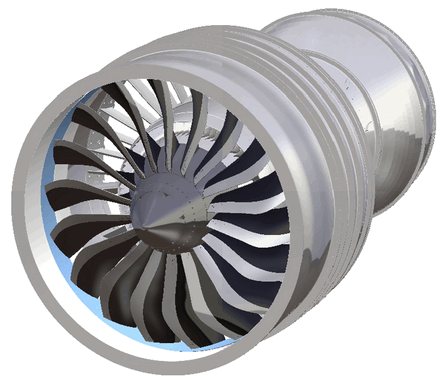 |
|---|
© CFM International |
Saia says the GTF will have a much higher bypass ratio than Leap-X: "We increase the bypass ratio by over 30%, relative to [the conventional turbofan] Leap-X. That drives real thermodynamic or physics-based improvement, in fuel and also in noise. The other big aspect is that we need fewer aerofoils to power the fan. We actually have 1,500 fewer aerofoils. Today's CFM has about 3,500 aerofoils."
Paul Adams, P&W's senior vice-president engineering, says the manufacturer is "confused" by CFM's Leap-X approach because "they talk about a conventional configuration, and then simultaneously with that they're doing an open rotor. Is it that they don't think the open rotor will work and they need a conventional engine, or is it because they don't think the conventional engine will be as good as the GTF and they need open rotor?"
P&W has a head start in the market following the selection of the smaller PW1000G GTF by Mitsubishi Heavy Industries to power its MRJ regional jet, and by Bombardier for its CSeries family.
R-R maintains that if it were to design a three-shaft engine using today's technology, it would be able to deliver comparable fuel efficiency to that of the GTF.
"Whenever you go into an aircraft competition, everyone ends up with the same size fan, because you take the fan that you can get under the wing that doesn't compromise the drag of the aircraft," says R-R's president of civil aerospace Mark King.
"In terms of fan speed, everyone gets the lowest-speed fan they can get, based upon the turbine. So this is the concept of de-coupling the turbine. Our three-shaft engine is essentially trying to achieve the same thing: de-coupling and putting the fan on its own shaft," he says.
OPEN ROTOR CHALLENGE
Though the open rotor concept promises attractive performance in terms of fuel consumption, there are considerable technical risks involved. The large diameter of the blades means that such an engine almost certainly cannot be mounted under the wing, which has implications for weight and drag. A reduction gearbox would be also be required. And with no fan case, limiting external noise will also be a major challenge, as will satisfying the certification authorities that the likelihood of a blade failure is extremely remote. And without the knowledge and experience that has resulted from the millions of flight hours accumulated by engines such as the CFM56 and V2500, reliability levels and maintenance and support costs will inevitably suffer, at least initially.
Open rotor engine-powered airliners would almost certainly fly slightly slower than A320s and 737s (around M0.75 versus M0.78), but they should be capable of climbing to cruising altitude more quickly, which together with intelligent scheduling of short-haul flights and air traffic management efficiency improvements should help to offset the impact.
The head of fleet planning for a major European flag carrier says that there is sufficient potential to improve the efficiency of European ATM for flying more slowly to make sense.
"Wasting more than 10% of our fuel means basically that we already spend more time travelling than we need to," he says. "As such, improvements on the air traffic control side and a reduction in cruise speed for short-haul aircraft could actually make sense.
"If you look at some airline schedules for today and in the past, you will find that the timetable block times have not really changed since the days of the Vickers Viscount, which had a much lower speed than today's 737s and A320s. However, cruise speed is not the only issue affecting flight times. But a slightly lower cruise speed - ideally coupled with a more shallow fuel-burn curve over speed - could be of interest unless it would require more aircraft to serve the same network, which would then just be a theoretical improvement."
STEP CHANGE
Despite the potential step-change reduction in engine fuel burn offered by open rotor, Airbus and Boeing have been tight-lipped over the potential for the technology's adoption for next-generation narrowbodies.
"We are analysing the integration and operational issues of open rotor compared to more 'traditional' approaches like Leap-X/GTF," says the fleet planning head.
"We need to see that the specific fuel consumption reduction of the engine is retained after installation. This therefore takes into account different weights and systems due to the likely tail-mounted design as well as available aircraft hours per day in our operation," he adds. "Should these things balance out and the fuel reduction still be there, then we will have to assess in detail the other new elements... however, technology-wise we believe that these items would be manageable."
R-R's King says that "ultimately aircraft manufacturers understand aircraft design. They will make decisions and it's only really possible to take an engine and optimise it once you've got an airframe concept against which you can try and say okay, given that aircraft concept, this is what I can provide.
"I think the aircraft manufacturers have to form their view and decide what aircraft they're going to offer to the marketplace," he adds. "We have to wait and see. We are saying to the aircraft manufacturers that we are ready to go as long as we understand the timeframe. We have a continuum of solutions."
The UK manufacturer has also called for a debate over whether, in the face of rocketing oil prices, the industry should accept a reduction in minimum time between overhauls for aircraft engines in return for bigger fuel savings. This would be achieved by using lighter parts and running engines at higher temperatures.
The fleet planning head says that such an approach could be attractive, depending on the magnitude of the reduction in fuel burn. "It is a soft issue, since when we look at the total life-cycle cost and environmental footprint, we need to consider if this actually would mean an extra aircraft due to the extra downtime [for maintenance]. As such, I cannot be precise without a given interval on a defined aircraft, which we would use in a theoretical flightplan to assess the benefits of fuel over maintenance schedule," he says.
At Farnborough, R-R said it could develop an advanced turbofan providing a 15% cut in fuel burn by "the middle of the next decade". The oil price has reached the point at which a three-shaft engine in the 150-seat class could make economic sense, despite the extra weight and maintenance cost compared with a two-shaft design.
However, a cut of up to 50% could eventually be achieved with the development of open rotor engines, coupled with airframe advances, operational changes such as flying slower and over shorter design ranges, and introducing new maintenance philosophies.
R-R is running a core-less, one sixth-scale open rotor demonstrator in the Netherlands as part of its efforts to validate the concept. It expects in future to develop a full demonstrator engine based on a BR700 core.
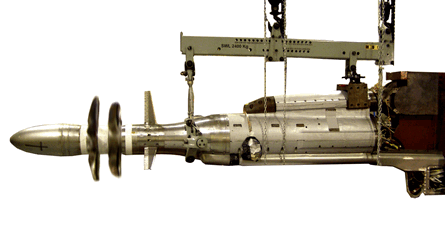 |
|---|
© Rolls-Royce |
"It's a rig which we've had for some time because we've looked at this a number of times over the years. It's got real open rotor blades and this rig is about demonstrating the noise and performance characteristics," says King. "We believe that we've come up with a unique way of managing the noise signature such that an open rotor would be lower noise than current technology engines. I think there's a whole installation question, with the aircraft, but if we can get the noise right then we can make this thing work."
Industry sources say that in addition to the shape of the blades, the key to R-R's noise reduction approach is the ratio of blade heights for the leading and trailing rotors.
Unlike GE and Snecma, which have promoted their technology acquisition and product development efforts under the CFM umbrella, P&W and R-R have said little about the future of their IAE consortium, other than to insist that their preferred route to market is through IAE. Industry sources suggest that IAE will have to be restructured and granted more autonomy if it is to continue to compete effectively against CFM and adapt to changes in the afermarket business.
Meanwhile, the airlines, many of which operate large fleets of current-generation narrowbodies, are becoming increasingly vocal in their calls for the new narrowbodies to be launched soon. They have been able to draw comfort from the positive signals given out by the engine makers at Farnborough, but will it be enough to spur the airframers into action?
"In reality, both have got to come to the table at roughly the same time," says EasyJet's Calamvokis. "One of the things that is probably driving it is [Europe's] Clean Sky joint technology initiative. If the engine manufacturers say we're just going to carry on doing what we're doing - that will default to you just get an evolutionary product," he says.
"If you're going to do anything that's a substantial step different you've got to think through and work on the risk management. We've got to step off the thing we know about and move into the unknown."
At Farnborough, CFM committed to developing a new baseline engine for next-generation narrowbody aircraft under the Leap-X banner, while continuing its open rotor work. "We are committed to the Leap-X schedule for 2016," says CFM executive vice-president Bill Clapper. "We are also committed to running the tests for the open rotor. When we get the open rotor data we will look at it. We are not holding Leap-X hostage to open rotor.
"Both [Boeing and Airbus] are very active," he adds. "We are bringing this to them so they can do their design studies. The airlines... continue to say what they want. We feel that we have to put this there to be evaluated. And then the aircraft manufacturers and airlines have to decide what they want to do next."
The open rotor work builds on the unducted fan flight-test programme of the late 1980s and will incorporate Leap-X technologies where appropriate.
"We believe that all these [Leap-X] technologies apply to open rotor, but there are more technologies required... with open rotor the carrot is 10% better fuel burn, but you must solve the noise problem," says Clapper.
Remaining challenges include the maintenance costs associated with the pitch-change mechanism of the blades and the counter-rotating nested turbine, and the installation of the engine - which could be 4.3m (168in) diameter - on the airframe.
AIRFRAME RETHINK
While open rotor engines will require a fundamental rethink of airframe configuration, P&W's GTF should fit under the wing of the existing A320 airframe (but not the 737), opening up the possibility of a retrofit programme or an interim solution for new-build aircraft. Airbus is about to begin test flights of a GTF mounted on an A340-600, but the airframer has avoided talking up prospects for offering the powerplant on the A320.
 |
|---|
The business case for such a move is complex, because it may suck up orders that would have been placed for an all-new replacement aircraft. Perhaps more importantly it could force Boeing to into an earlier launch decision for its all-new 737 successor, requiring its European rival to follow suit and simultaneously undermining the potential market for an interim GTF-powered A320. Finally, work on an A320 "refresh" would require Airbus to divert engineering resources away from work on an all-new single-aisle airliner.
"One of the big questions is the capabilities within the manufacturers," says one low-cost airline executive. "If you're going to some form of hybrid or interim product, is that the best solution for the people in Toulouse or Seattle to be spending their time and effort on, as opposed to getting on and working on the new product?"
Another European flag carrier's head of fleet planning says he would encourage the manufacturers to "do their utmost to reduce fuel consumption. However, to have this short-term gain, we ought not postpone the new programmes with the incremental benefits. We'd rather focus on the final solution than have an interim change take the focus off the real solution."
Airbus says it could certificate a GTF-powered A320 derivative within 24-30 months of a launch decision.
"P&W thinks it's a great idea and the aircraft could take a third engine, but a lot depends on how that engine programme looks," says Airbus chief operating officer customers John Leahy. "But right now, nobody is coming to us saying we'd place an order for 50 A320s if you put a GTF on."
Airbus executive vice-president programmes Tom Williams says Airbus will "wait and see what the data tells us" from the GTF flight trials. "Putting a new engine on an aircraft is not a trivial exercise. It requires several hundred million dollars of investment, so it's a decision that needs a lot of care and attention," he adds.
Source: Flight International

